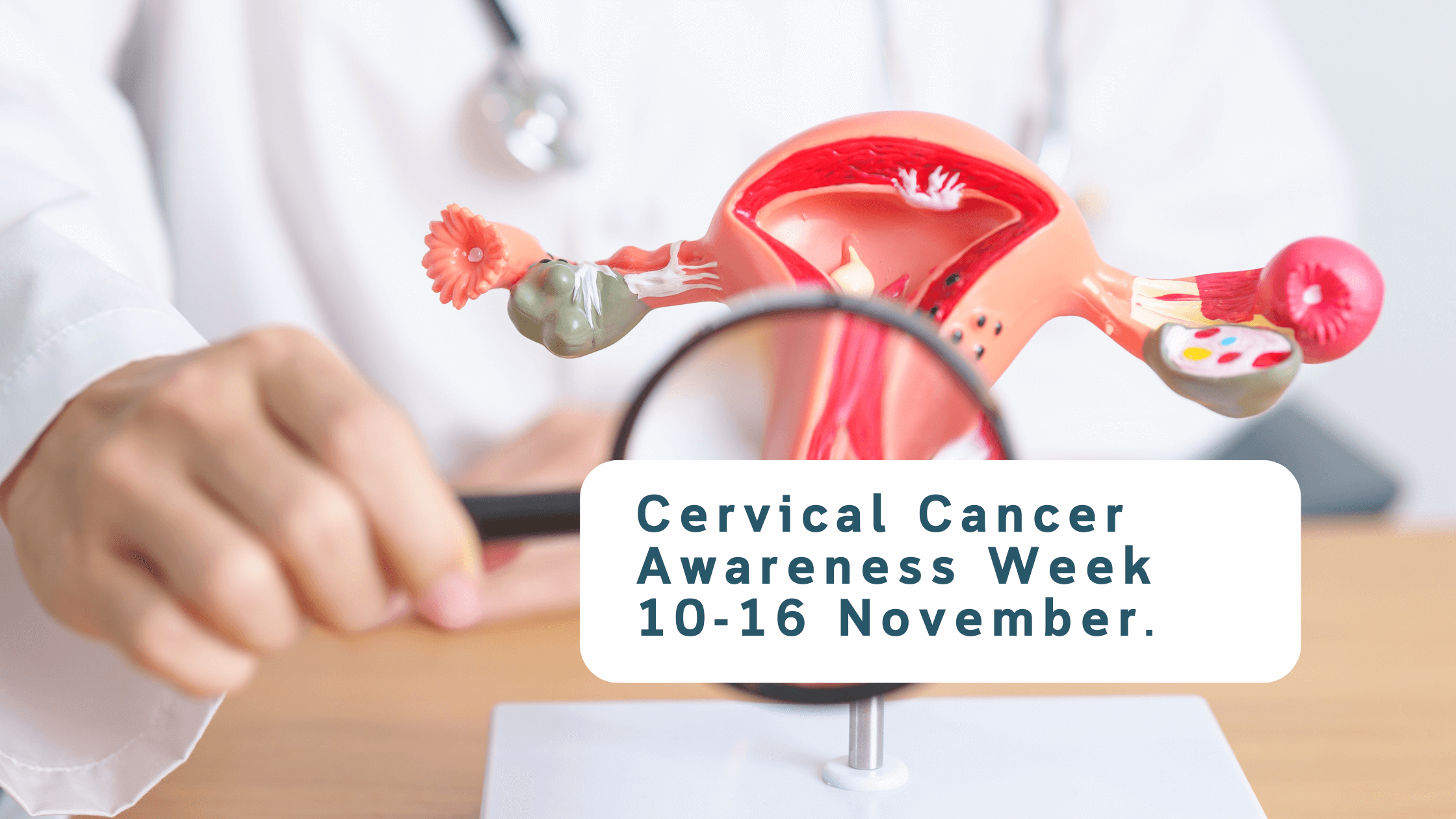Cervical Cancer Awareness Week 10-16 November.
What women over 50 need to know.
Why Cervical Cancer Awareness matters: -
Cervical Cancer Awareness Week is led by the Australian Cervical Cancer Foundation (ACCF) to educate and raise awareness about cervical cancer prevention. Despite being the 13th most common cancer in Australian women, it’s highly preventable with regular cervical screening and the HPV vaccine.
This year’s theme, “The Power of Choice,” highlights the growing prevention options, including:
Free HPV vaccine for those under 25.
Cervical screening every five years for women and those with a cervix aged 25–74.
With a 74% survival rate and progress towards global prevention goals, Australia is leading the way in making cervical cancer history.
Highlight how awareness empowers women over 50 to make informed health decisions.
How common is cervical cancer in Australia?
Australia statistics for cervical cancer: -
Estimated number of new cases of cervical cancer diagnosed in 2024 = 1030 females.
Estimated number of deaths from cervical cancer in 2024 = 243 females
Chance of surviving at least 5 years (2014–2020) = 75.5%
Females living with cervical cancer at the end of 2020 (diagnosed in the 5 year period 2016 to 2020)= 3 787 - Australian Government Cancer Australia
Cervical cancer is most commonly diagnosed in women over 30, but it can occur at any age. - Cancer Council
Understanding cervical cancer: -
What is cervical cancer?
Cervical cancer is the growth of abnormal cells in the lining of the cervix. The most common cervical cancer is squamous cell carcinoma, accounting for 70% of cases.
Adenocarcinoma is less common (about 25% of cases) and more difficult to diagnose because it starts higher in the cervix. - Cancer Council
The average age at diagnosis is 50 years old.
Causes of cervical cancer: -
Almost all cases of cervical cancer are caused by persistent infection with some high-risk types of the human papillomavirus (HPV); this is the biggest risk factor for cervical cancer. The other main risk factor for cervical cancer is smoking.
There is some evidence that women who have taken the contraceptive pill for five years or more are at increased risk of developing cervical cancer in people with HPV. The risk is small and taking the pill has also been shown to reduce to risk of other cancers such as ovarian and uterine.Other risk factors include:
smoking and passive smoking
a weakened immune system
Using oral contraceptives (the pill) for a long time
if your mother was prescribed diethylstilbestrol (DES), an artificial form of the female hormone oestrogen during pregnancy (between 1939 and 1971).
Around eight out of 10 women will become infected with genital HPV at some time in their lives.
Most women who have the HPV infection never get cervical cancer; only a few types of the HPV result in cervical cancer. - Cancer Council
Key prevention steps for women over 50: -
A. Screening for cervical cancer
The Pap smear test has changed to the new Cervical Screening Test.
Australia has halved cervical cancer incidence and deaths since the National Cervical Screening Program began in 1991, initially offering free Pap smears every two years. In 2017, the program transitioned to the Cervical Screening Test, which screens for HPV and is more effective.
Key changes in the program: -
Screening interval: Women aged 25–74 now screen every five years instead of every two.
HPV vaccination: Introduced in 2006, free for ages 12–25, offered through schools for 12–13-year-olds.
Self-collection option: From July 2022, participants can collect their own sample in a private setting or choose a clinician-collected sample.
Screening methods: -
Self-collection: Done privately using a swab provided by a healthcare provider. Sui
table for those without symptoms.
Clinician-collected: A doctor or nurse collects cervical cells with a speculum.
These advancements, alongside vaccination, aim to make Australia the first country to eliminate cervical cancer as a public health issue. For more details and common questions about cervical screening, visit the Cancer Council or the National Cervical Screening Program.
B. Preventing cervical cancer: HPV vaccine
The HPV vaccine, Gardasil 9, protects against nine HPV types responsible for around 90% of cervical cancers.
It’s provided free through Australia’s National Immunisation Program to boys and girls aged 12–13 in school-based programs and is available to everyone aged 12–25 as a single injection.
Even if vaccinated, regular Cervical Screening Tests are essential, starting at age 25 and continuing every five years. For more details, visit the Cancer Council’s cervical screening page.
Symptoms to watch for: -
Precancerous changes in cervical cells typically don’t cause symptoms, which is why regular cervical screening tests are essential to detect any abnormal cells that may develop into cancer.
If cervical cell changes progress to cervical cancer, common symptoms may include:
vaginal bleeding between periods or after menopause
bleeding during or after sex
pain during sex
pelvic pain
menstrual bleeding that is heavier or lasts longer than usual
unusual vaginal discharge, such as an increase in discharge or changes in its colour, smell, or consistency.
In advanced cases of cervical cancer, symptoms can include:
extreme tiredness
leg pain or swelling
lower back pain.
These symptoms can result from other conditions, but if you experience unusual bleeding, discharge, or pain, it’s important to consult your doctor. Anyone with a cervix should prioritise cervical health, regardless of gender identity or sexual orientation.
Diagnosis of cervical cancer: -
If your cervical screening test results or symptoms suggest a higher risk of cervical cancer, further tests may be needed. These help doctors see the cervix more clearly, assess general health, and determine if the cancer has spread. Although the exact progression of the disease cannot be predicted, these tests provide vital information for diagnosis and treatment. For more info, click here.
-
A colposcopy is a procedure that magnifies the cervix, vagina, and vulva to identify abnormal or changed cells. It takes 10–15 minutes and may include applying a liquid to highlight areas of concern. If suspicious cells are seen, a biopsy (removal of tissue for lab analysis) may be performed.
After the procedure, you may experience mild cramping, light bleeding, or discharge. To promote healing and prevent infection, avoid tampons and sexual intercourse for a few days.
Additional tests
If cervical cancer is confirmed, staging tests may include:
Blood tests to assess overall health.
Chest X-rays to check for lung involvement.
Ultrasound, CT, MRI, or PET scans to examine the extent of cancer and its spread.
These tests help doctors plan the most effective treatment. If you have concerns, consult your doctor promptly.
Source: Australian Government Cancer Australia and Cancer Council
Treatment types: -
Overview
Cancer treatments are tailored to the individual, considering the type and stage of cancer, genetic factors, age, health, and personal preferences. A multi-disciplinary team (MDT) often provides care. Treatments can include surgery, radiation therapy, chemotherapy, and targeted therapy, used alone or in combination.
-
Not all abnormalities need treatment, but those that do can often be managed successfully. Common options include:
Loop excision (LLETZ or LEEP): Removes abnormal tissue using a heated wire loop, performed under local or general anaesthetic. Recovery includes 4–6 weeks of avoiding tampons, sex, and hot tubs.
Cone biopsy: Removes a cone-shaped section of the cervix, used for early-stage cancer or diagnosis. May require hospitalisation and has a longer recovery period.
Laser surgery: Uses a laser to remove abnormal cells; typically allows quick recovery.
Cryosurgery: Freezes and kills abnormal cells using a cold metal probe.
-
Treatment depends on the cancer’s type, stage, spread, and patient preferences (e.g., fertility goals):
Cone biopsy: For very small tumours.
Trachelectomy: Removes the cervix while preserving fertility.
Hysterectomy: Removes the uterus and cervix; may also involve removing fallopian tubes and/or ovaries if needed.
Pelvic exenteration: For advanced cancer, removes affected organs and may require creating stomas for waste elimination.
External beam radiation therapy: Targets the pelvis, often combined with chemotherapy.
Brachytherapy: Places a radiation source inside the cervix.
Administered intravenously in cycles. Commonly combined with radiation for advanced stages. Platinum-based drugs are typical for stages II–IV.
Bevacizumab: Stops cancer cells from forming blood vessels. Used for advanced or recurring cancer.
Immunotherapy is a cancer treatment that uses the body’s immune system to fight cancer. The most common type, checkpoint inhibitors, helps the immune system identify and attack cancer cells. Other forms, like CAR T-cell therapy and oncolytic virus therapy, are still largely experimental.
Usage: Often used for advanced or recurrent cancers, sometimes alongside other treatments. It may also be included in initial treatment plans for some cases.
Cancers treated: Includes melanoma, lung, kidney, bladder, and certain lymphomas, among others.
Effectiveness: Success varies by cancer type and individual factors. Doctors consider cancer type, stage, treatment history, and overall health before recommending it.
To explore immunotherapy options, consult your specialist to discuss suitability and PBS reimbursement for your cancer type.
Combination therapy
Chemoradiation (chemotherapy + radiation) is often used for advanced cases, though it can cause severe side effects, such as nausea and low white blood cell counts.
Considerations
Fertility: Procedures like cone biopsy and trachelectomy may preserve fertility.
Side Effects: These vary by treatment and may include menopause (if ovaries are removed), lymphoedema (after lymph node removal), or issues with bladder or bowel function.
Source: Australian Government Cancer Australia and Cancer Council
How you can take action this week: -
Schedule your cervical screening if overdue.
Encourage friends or family members to stay up to date with screening and vaccination.
Share awareness on social media or through community groups.
Where to learn more
Link to trusted resources (e.g., Australian Government Cancer Australia, Cancer Council).
Information on finding local services for cervical screening and vaccination. NSW
To download Cancer Council’s cervical cancer booklet: Everything you need to know, click here.
How to get involved
Raise awareness about cervical cancer prevention.
Share the message with friends and family.
Join the fun by fundraising with your loved ones.
Your choices today can help protect your future.
Final thoughts
Cervical cancer is preventable and treatable when caught early. As women over 50, staying informed and proactive about your health is one of the best gifts you can give yourself and your loved ones.



